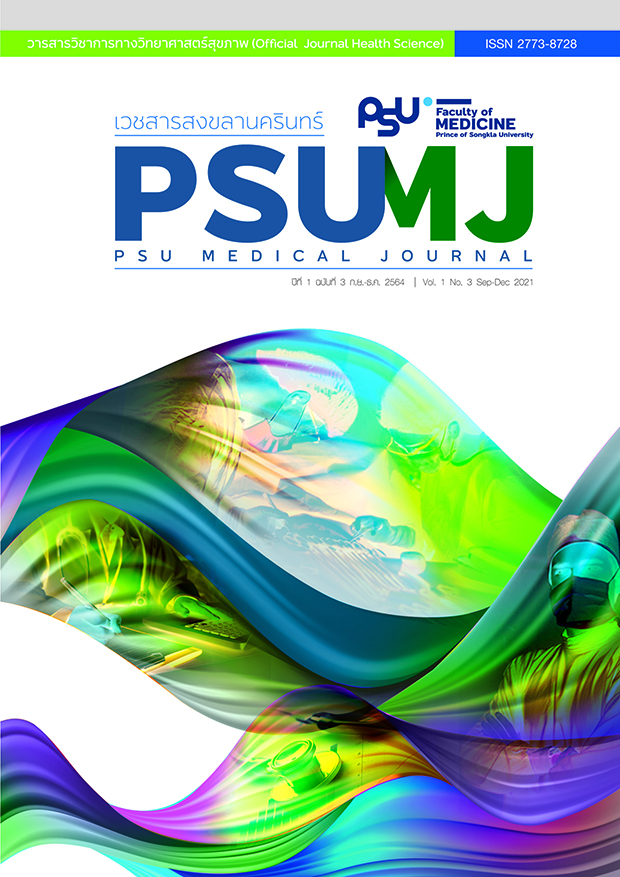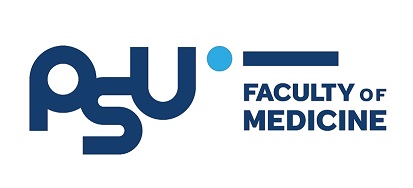TP53 Intronic Polymorphisms and Risk of Esophageal Cancer in Southern Thai Population
TP53 Intronic Polymorphism and Esophageal Cancer
DOI:
https://doi.org/10.31584/psumj.2021247101Keywords:
esophageal cancer, intronic variation, risk TP53, polymorphismAbstract
Objective: The study aimed to determine the frequency of intron 3 16 base pair (bp) duplication polymorphism and intron 6 G to C substitution (G>C) of the TP53 gene and to evaluate the association these two intronic variants with the risk of esophageal cancer (EC).
Material and Methods: A case-control study was conducted to evaluate the frequency and association of cancer. Cases were patients with squamous cell carcinoma of esophagus and controls were age and sex-matched non-cancer patients. Blood samples were also obtained from healthy blood donors. Polymerase chain reaction (PCR) was used to detect intron 3 16 bp duplication and PCR-restriction fragment length polymorphism was applied to detect intron 6 G>C. Logistic regression was used for the analysis.
Results: Heterozygous intron 3 16 bp duplication (Del/Ins) was found in 10.1% (31/308) of blood donors, 9.3% (28/302) of controls and 8.6% (26/301) of EC cases. Intron 6 G>C was found in 0.3% (1/308) of blood donors, in 2.6% (8/310) of controls and 3.9% (12/307) of EC cases. Both variants displayed no significant association with risk of esophageal cancer (odd ratio (OR) = 1.16 [95% confidence interval (CI) = 0.64–2.11] for intron 3 16 bp duplication and OR = 0.81 [95% CI = 0.47-4.61] for intron 6 G>C.
Conclusion: Southern Thai population have low frequency of intron 3 16 bp duplication polymorphism and intron 6 G>C variant, both of which are not likely to be associated with esophageal cancer susceptibility.
References
Bray F, Ferlay J, Soerjomataram I, Siegel RL, Torre LA, Jemal A. Global cancer statistics 2018: GLOBOCAN estimates of incidence and mortality worldwide for 36 cancers in 185 countries. CA Cancer J Clin 2018;68:394–424.
Imsamran W, Pattatang A, Supaattagorn P, Chiawiriyabunya I, Namthaisong K, Wongsena M, et al. Cancer in Thailand. Bangkok: Ministry of Public Health; 2018;IX:2013–5.
Olivier M, Hollstein M, Hainaut P. TP53 mutations in human cancers: origins, consequences, and clinical use. Cold Spring Harb Perspect Biol 2010;2:a001008.
Vos M, Adams CH, Victor TC, van Helden PD. Polymorphisms and mutations found in the regions flanking exons 5 to 8 of the TP53 gene in a population at high risk for esophageal cancer in South Africa. Cancer Genet Cytogenet 2003;140:23–30.
Thongsuksai P, Boonyaphiphat P, Puttawibul P, Sudhikaran W. Specific intronic p53 mutation in esophageal squamous cell carcinoma in Southern Thailand. World J Gastroenterol 2010;16:5359–66.
Bouaoun L, Sonkin D, Ardin M, Hollstein M, Byrnes G, Zavadil J, et al. TP53 Variations in Human Cancers: New Lessons from the IARC TP53 Database and Genomics Data. Hum Mutat 2016;37:865–76.
Lehman TA, Haffty BG, Carbone CJ, Bishop LR, Gumbs AA, Krishnan S, et al. Elevated frequency and functional activity of a specific germ-line p53 intron mutation in familial breast cancer. Cancer Res 2000;60:1062–9.
Barnoud T, Parris JLD, Murphy ME. Common genetic variants in the TP53 pathway and their impact on cancer. J Mol Cell Biol 2019;11:578–85.
Lazar V, Hazard F, Bertin F, Janin N, Bellet D, Bressac B. Simple sequence repeat polymorphism within the p53 gene. Oncogene 1993;8:1703–5.
Weston A, Pan CF, Ksieski HB, Wallenstein S, Berkowitz GS, Tartter PI, et al. p53 haplotype determination in breast cancer. Cancer Epidemiol Biomarkers Prev 1997;6:105–12.
Wang-Gohrke S, Becher H, Kreienberg R, Runnebaum IB, Chang-Claude J. Intron 3 16 bp duplication polymorphism of p53 is associated with an increased risk for breast cancer by the age of 50 years. Pharmacogenetics 2002;12:269–72.
Gemignani F, Moreno V, Landi S, Moullan N, Chabrier A, Gutierrez-Enriquez S, et al. A TP53 polymorphism is associated with increased risk ofcolorectal cancer and with reduced levels of TP53 mRNA. Oncogene 2004;23:1954–6.
Perfumo C, Bonelli L, Menichini P, Inga A, Gismondi V, Ciferri E, et al. Increased risk of colorectal adenomas in Italian subjects carrying the p53 PIN3 A2-Pro72 haplotype. Digestion 2006;74:228–35.
Wu X, Zhao H, Amos CI, Shete S, Makan N, Hong WK, Kadlubar FF, Spitz MR. p53 Genotypes and haplotypes associated with lung cancer susceptibility and ethnicity. J Natl Cancer Inst 2002;94:681–90.
Hu Z, Li X, Qu X, He Y, Ring BZ, Song E, Su L. Intron 3 16 bp duplication polymorphism of TP53 contributes to cancer susceptibility: a meta-analysis. Carcinogenesi 2010; 31:643–7.
He XF, Su J, Zhang Y, Huang X, Liu Y, Ding DP, et al. Association between the p53 polymorphisms and breast cancer risk: meta-analysis based on case-control study. Breast Cancer Res Treat 2011;130:517–29.
Umar M, Upadhyay R, Khurana R, Kumar S, Ghoshal UC, Mittal B. Role of p53 and p73 genes polymorphisms in susceptibility to esophageal cancer: a case control study in a northern Indian population. Mol Biol Rep 2012;39:1153–62.
Malik MA, Sharma K, Goel S, Zargar SA, Mittal B. Association of TP53 intron 3, 16 bp duplication polymor- phism with esophageal and gastric cancer susceptibility in Kashmir Valley. Oncol Res 2011;19:165–9.
Costa S, Pinto D, Pereira D, Rodrigues H, Cameselle- Teijeiro J, Medeiros R, Schmitt F. Importance of TP53 codon 72 and intron 3 duplication 16bp polymorphisms in prediction of susceptibility on breast cancer BMC Cancer 2008;8:32.
Sagne C, Marcel V, Amadou A, Hainaut P, Olivier M, Hall J. A meta-analysis of cancer risk associated with the TP53 intron 3 duplication polymorphism (rs17878362): geographic and tumor-specific effects. Cell Death Dis 2013;4:e492.
Hao W, Xu X, Shi H, Zhang C, Chen X. No association of TP53 codon 72 and intron 3 16 bp duplication poly- morphisms with breast cancer risk in Chinese Han women: new evidence from a population-based case-control inves- tigation. Eur J Med Res 2018;23:47.
Mabuchi F, Sakurada Y, Kashiwagi K, Yamagata Z, Iijima H, Tsukahara S. Lack of association between p53 gene poly- morphisms and primary open angle glaucoma in the Japa nese population. Mol Vis 2009;15:1045–9.
Hiyama K, Takeda M, Shirotani Y, Ishioka S, Awaya Y, Inai K, et al. Duplication polymorphism within the third in tron of the p53 gene is a rare event in Japanese population. Jpn J Hum Genet 1994;39:193–5.
Lee DS, Yoon SY, Looi LM, Kang P, Kang IN, Sivanandan K, et al. Comparable frequency of BRCA1, BRCA2 and TP53 germline mutations in a multi-ethnic chort suggests TP53 screening should be offered together withBRCA1/2 screening to early-onset breast cancer patients. Breast Cancer Res 2012;14:R66.








